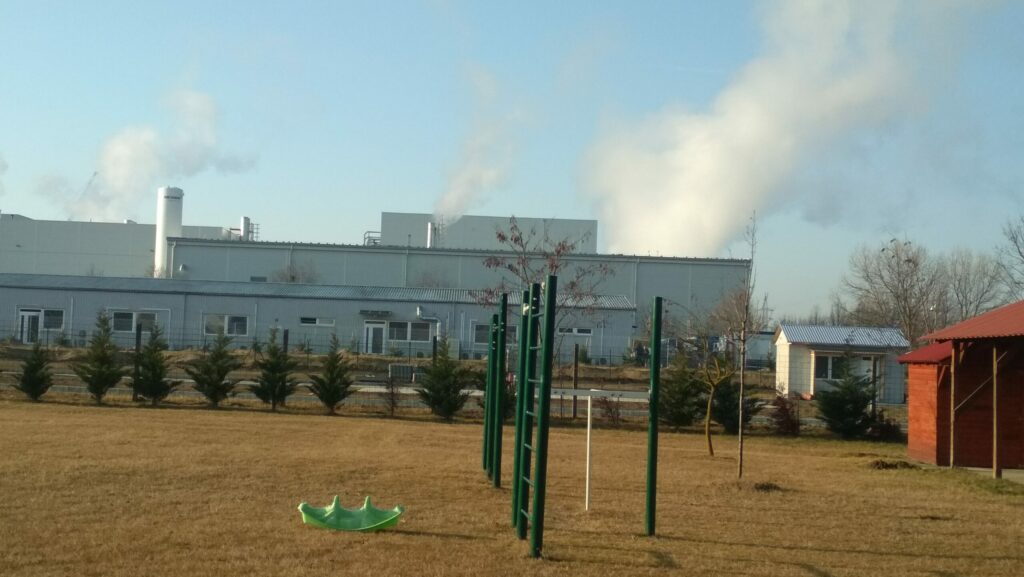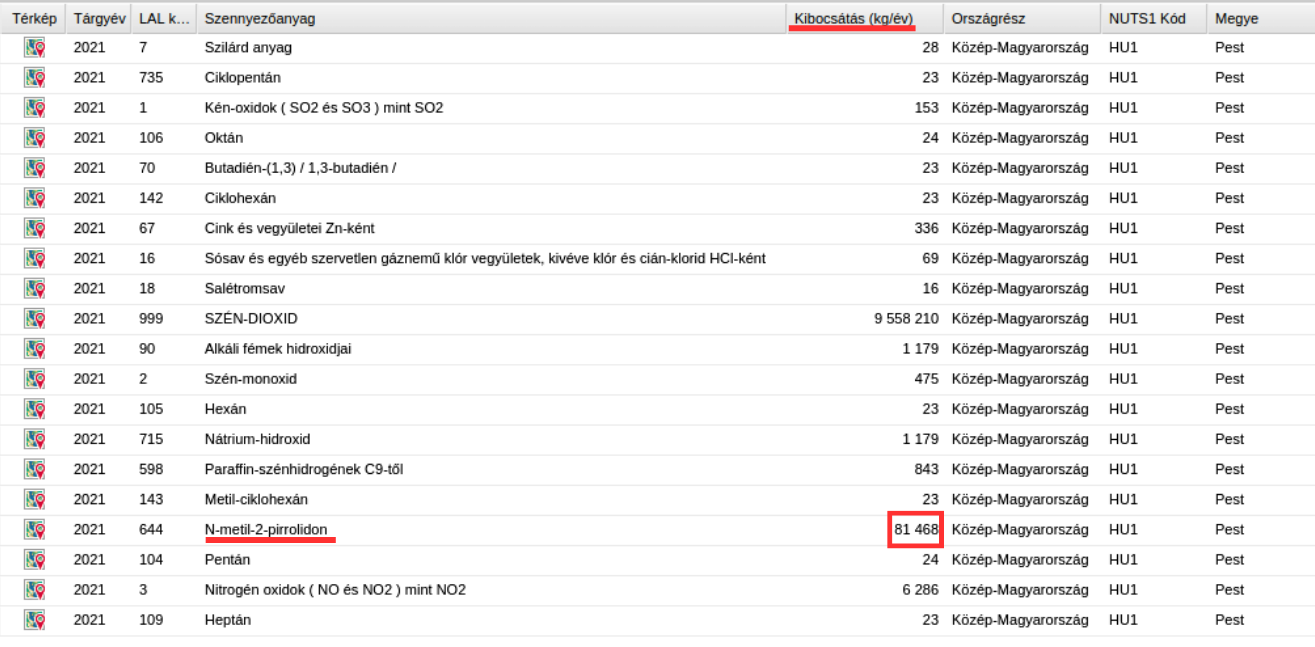The https://english.atlatszo.hu use cookies to track and profile customers such as action tags and pixel tracking on our website to assist our marketing. On our website we use technical, analytical, marketing and preference cookies. These are necessary for our site to work properly and to give us inforamation about how our site is used. See Cookies Policy
Göd battery factory: 88 tonnes of fetotoxic solvents in the air, heavy metals in workers’ immune systems
Air pollution data shows that Samsung SDI’s Göd plant emitted 88 tons of toxic solvents into the air between 2019 and 2022. Like the battery processing plants of SungEel Ltd, the Göd factory housed many times the permitted levels of carcinogenic heavy metals. Workers’ exposure to toxic substances has increased steadily over the years. The government, in response, kept increasing the level of health and safety fines. It may not prevent workers from getting cancer, but at least someone pays a fine – any complaints?
New data and documents show that there has been alarming levels of pollution in and around the Göd battery factory. Investigations into the toxic substances emitted by the factory and in-house reports show that the company is failing to meet even the most basic environmental and occupational safety standards.

We requested the 2021 and 2022 air pollution data for the city of Göd and the Samsung factory because they were not available in the National Environmental Information System (OKIR) in January this year. They have since been uploaded to OKIR.
Tons of fetotoxic solvents released
The data shows that the battery factory is a major pollutant in Göd, with carbon dioxide levels up sevenfold compared to 2018. But the truly worrying figure is the amount of the toxic organic solvent N-methyl-2-pyrrolidone (NMP) used in electrode production.
NMP is used as an organic solvent in various manufacturing processes (petrochemicals, pharmaceuticals, surface treatment), but in Göd, it is only found in large quantities in the battery factory. The substance is classified as a fetotoxin, and its inhalation poses a risk primarily to pregnant women. Prolonged exposure to NMP may cause miscarriage or abnormal fetal development.
Between 2019 and 2022, a total of 88 tons of this fetotoxic solvent was released into the air in Göd.
The peak emission occurred in 2021, when 81,468 tons of NMP were emitted from the plant’s pollutant point sources.
The solvent was found in Göd’s well water by an independent study – and yet, no full fact-finding investigation was launched into the water contamination. Authorities said it was “not proven” that the contamination came from the battery factory.
At the same time, the monitoring wells haven’t been functioning in the Samsung SDI industrial area for five year. The only monitoring well was buried during construction and no new wells were built – because of the factory’s “insignificant environmental impact.”
False expectations of higher limits
The impact assessment documentation for the environmental review process of the Samsung plant, due in summer 2023, does not provide information on the volume of pollutants released. The review was based on measurements carried out and submitted by Samsung SDI Hungary Zrt.
According to the measurements carried out by Samsung SDI, the emissions of air pollutants did not exceed the prescribed limits. The again, the document also shows that the Göd battery plant did not apply the legal emission limit values for NMP – which makes their conclusion less than valuable.
The VM Decree 26/2014 (25.III.) states that, in the case of “end-gases of carcinogenic, mutagenic or toxic for reproduction substances,”
the emission limit value is 2 mg/m3. But for all air pollutant point sources emitting NMP at the Göd plant, an emission limit value of 150 mg/m3 was imposed.
The significantly lower limit value of 2 mg/m3 should have been applied to the vents with the wet scrubbers. A December 2023 permit corrects this “omission” by requiring a stricter limit value for NMP in the future. It also dictates that Samsung SDI Hungary Zrt carry out measurements every six months instead of once a year.
The 81.4 tons of highly soluble NMP released into the air in 2021 could have travelled long distances through the significant amount of water vapor emitted by the plant and precipitation, according to experts we interviewed.
It is a rapidly biodegradable substance that becomes toxic in aqueous environments. And yet, the authorities have not investigated where and how much of the solvent was released into the air and what the environmental and health risks are.
Factory workers exposed to carcinogens for years
Just a week ago, we wrote about the toxic substances that were found in the air at SungEel’s battery processing plant. After the Pest County Government Office sent us the documents with the names and quantities of the carcinogens, we requested the public data of the Samsung factory in Göd.
In 2021 and 2022, a total of 133 workers were found to have been exposed to carcinogenic material on seven occasions, and a further 44 workers were found to have been exposed to increased levels of chemicals at the battery factory in 2023.
The 2021 tests showed that the permissible concentrations of nickel and cobalt in the workplace air were ten and twenty times the limit.
Despite the HUF 10 million fine, the air filtration equipment continued to fail in the following years, and occupational health and safety regulations were ignored. According to measurements taken in June 2023, the nickel content was 250 times higher than the permitted level. Samsung SDI Hungary Zrt was fined HUF 10 million twice last year for endangering workers. Excellent – the fine was so effective the first time around.
The government agency had, in principle, set higher fines – HUF 15.5 million, HUF 17.7 million and HUF 20.7 million – for the serious safety violations, but the maximum fine under the OSH Act cannot exceed HUF 10 million. Samsung SDI, which had been endangering its workers for years, got away with a total of HUF 30 million in OSH fines. It’s less than a drop in the ocean, considering that, in 2022, it had a turnover of HUF 1631 billion and a profit of nearly HUF 31 billion.
The government wants to increase fines to crack down on dangers
The growing number of serious hazards in battery plants may have been a factor in the government’s decision to tighten up health and safety fines from March 1. The decree, published in the Hungarian Gazette on 14 February, stated that
the maximum amount of an OSH fine will be increased from HUF 10 million to HUF 100 million,
and the fine will jump from HUF 50,000 to HUF 100,000 per employee at serious risk. Companies will also have to pay more for offences that cause increased exposure or fatal accidents.
“The amount of the fine can increase several times over depending on the number of offences and the duration of the risk,” wrote the Ministry of National Economy in a statement on February 16. “Any aggravating factors in the case of irregularities could increase the amount of the fine even further.”
And while the sentiment is there – the spirit of deterrence is admirable – again, it is uncertain how this will actually affect companies like Samsung SDI Magyarország Zrt. or SungEeel Kft.. They generate revenues of up to several hundred billion a year – a thousand here or a thousand there, what does it matter to them?
Translated by Vanda Mayer. The original, Hunagrian version of this story was written by Zsuzsa Bodnár and can be found here. The article was produced with the support of the Union Values Programme.


